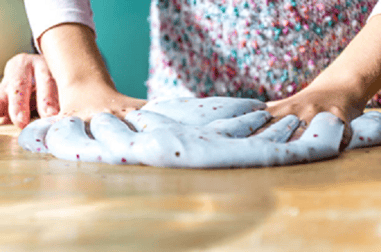Making slime is a popular activity for kids. If you can get past the mess, there are loads of benefits. The tactile experience taps into a child’s inter-scientist whose mission is to determine how adding and taking away certain ingredients can change the outcome of the slime.
This low-stress activity can be therapeutic and relaxing as children play with the slime they created. And let’s face it…It’s FUN!
Try one of the slime recipes below to keep your child engaged and learning all summer long. Each one uses household items.

Basic Slime
- 1 cup glue
- 1 tsp baking soda
- 2 to 3 tsp of contact solution
- *add shaving cream to make slime fluffy*
Cloud Dough
- 2 cups of cornstarch
- 1 cup of conditioner
Edible Slime
- 6-8 large marshmallows
- 1 Tbl cooking oil
- ½ Tbl cornstarch
- Microwave marshmallows and oil. After cooling, add cornstarch and knead.
Butter Slime
- 2-3 Tbl dish soap
- 3 oz. dried out playdough
- optional: cornstarch
Silly Putty Slime (edible)
- ½ cup cornstarch
- 1.55 oz package sugar-free gelatin
- Water - as needed (start with 2 Tbl)
Sprinkle in Some Science
There is so much science behind slime. Once you and your child have made slime and played with it, keep going! You can quickly transform playtime into a science lesson by discussing the scientific method and how it can be applied to slime creation.
Remember, the scientific method includes the following steps:
- Ask questions
- Collect information
- Make a guess (hypothesis)
- Try it (experiment)
- Observe the results
- Share and retest
For older children, take your science lesson to the next level. Help your child learn about words such as viscosity, variable, and polymer. Here’s a cheat sheet in case you need it.
- Viscosity describes how much the slime flows. Does the slime hold shape and move slowly like syrup, or would it flow down a hill quickly like water?
- Viscosity refers to how ooey and gooey your slime is.
- A variable is something that can be changed in an experiment.
- Slime is a polymer because it is made up of a long chain of repeating molecules. These long chains slide past each other, giving slime its elastic qualities.
Bonus Question: Is slime a liquid or a solid?
Now get to work on your slimy summer science lesson. Have fun!
 Megan Smith is a Technology Education and Art Teacher with Lincoln Learning Solutions and has been with the company for 9 years. As a mom of four slime-loving kids, Megan has come a very long way from starting as a mom who didn’t allow kids to mix Play-doh colors!
Megan Smith is a Technology Education and Art Teacher with Lincoln Learning Solutions and has been with the company for 9 years. As a mom of four slime-loving kids, Megan has come a very long way from starting as a mom who didn’t allow kids to mix Play-doh colors!


